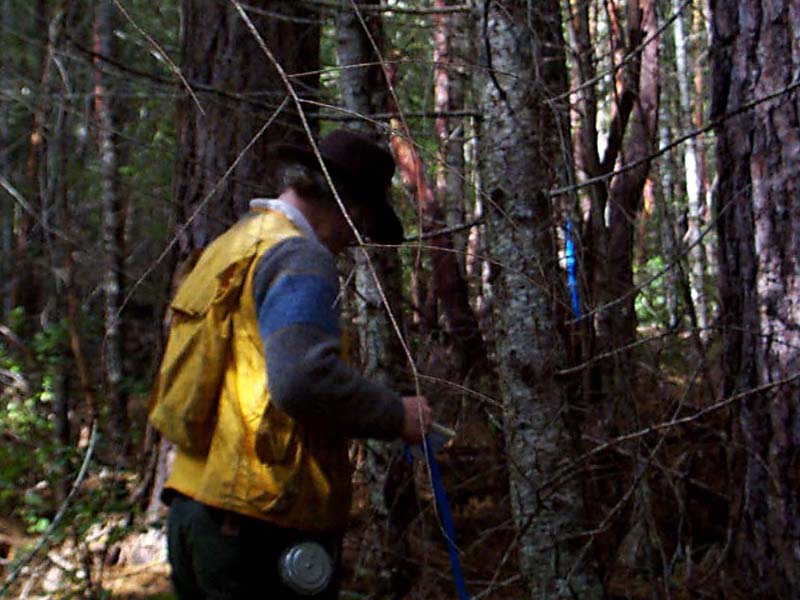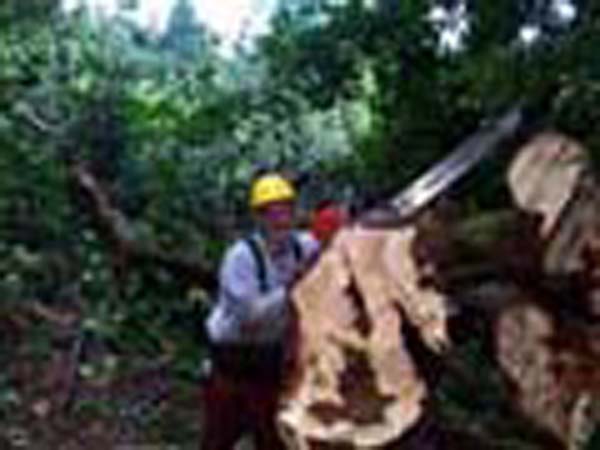
Barnes measuring diameters

The Ecoforestry Institute has developed a Management Team with the following goals: To manage and co-manage forest lands; to seek FSC certification so that for all the forests EI manages, the management plans and practices will be certified; and to provide advisory services to forest land owners.
EI arranges, when it can, funding for many projects. For the Mountain Grove Forest, it has a Stewardship Incentive Plan (SIP) matching grant for Wildlife Habitat Restoration, Umpqua Watershed Council monies, and a grant from Partners for Wildlife, a federally funded project.
The current management team includes, David Parker, David Perry, Mike Barnes, and Alan Wittbecker. Members of the EI Advisory Board, including Alan Drengson, Merve Wilkinson, Chris Maser, and Ray Travers, offer guidance to the team.
Justification for Management. Forests have regenerated so successfully that they may be the most successful ecosystem ever established on the land. Forests do not seem to require human management to be incredibly productive, healthy, and diverse. We justify managing wild forests because human populations need the goods and services provided by forests. We also manage them because unregulated cutting and practices in the last century have diminished the forests.
Management is now considered necessary to restore trees to previously forested areas, to preserve the genetic information in forests, and to iron out the boom and bust cycles of wild nature by controlling environmental factors, such as mineral deficiencies, as much as possible. For its management EI considers a long-term time-scale, up to a bioregional spatial scale, using an ecosystem orientation, with an emphasis on maintaining forest health, cooperation between agencies, and responsiveness to local communities and native species.
Ecoforestry Management. Although Ecoforestry can be characterized as single-tree selection, it is based on principles, ethical ideas, and cultural traditions, which can only be applied on a site basis. For this reason, ecoforestry is more flexible and less rigid than other programs or systems.
For some foresters, management is opening the forest to logging, but management is not simply harvesting, although harvesting is a small part of it. In forests that are managed for conservation, research, watershed protection, or recreation, there may be no harvesting at all. Management is an umbrella for silviculture, inventory, harvesting, finance, and social relations. Furthermore, Ecoforestry management is cognizant of many kinds of management, including adaptive management, ecomanagement, ecosystem management, holistic resource management, integrated resource management, permaculture, sustained yield management, and watershed management.
Management has to cover the spectrum from harvesting to preservation and restoration. Numerous things have to occur for a forest to be sustainable: Preservation, reservation, protection; conservation of soil and air quality; support for diversity, genetic, species, and ecosystemic; control by local populations, especially important for indigenous peoples, who need forests for survival; and the design and planning of forest areas, so that global cycles do not break down, as well as that human needs can be met. Once forests become sustainable, management can be for sustainability. But sustainable forests or sustained yield will depend on social as well as environmental conditions. Perhaps the most important condition is the security of land tenure. Management has never invested in land that is regularly changing ownership from the government to tribal to individual or back.
Management has to be aware of the limits of knowledge and be cautious. The forest should not be risked in one approach. Our knowledge of the forest is spotty, biased, and deficient; our knowledge of the effectiveness of our management is extremely incomplete. Our data is inadequate; too little is analyzed; our analysis of the little is often incorrect. A management scheme that was respectful and cautious, as well as low-impact and flexible, would be more effective in the long-run than a risk-all approach under the illusion of complete control.
Mike Barnes cutting maple burl

For more information about Ecoforestry management, please call or write: EMT, The Ecoforestry Institute
Post Office Box 370
Tallevast, Florida 34270 or: emt@ecoforestry.net
Back to EI main page.